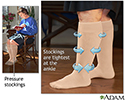Deep vein thrombosis - discharge
DVT - discharge; Blood clot in the legs - discharge; Thromboembolism - discharge; Venous thromboembolism - deep vein thrombosis; Post-phlebitic syndrome - discharge; Post-thrombotic syndrome - discharge
You were treated for deep vein thrombosis ( DVT ). This is a condition in which a blood clot forms in a vein that is not on or near the surface of the body.
DVT
Deep vein thrombosis (DVT) is a condition that occurs when a blood clot forms in a vein deep inside a part of the body. It mainly affects the large ...

It mainly affects the large veins in the lower leg and thigh. The clot can block blood flow. If the clot breaks off and moves through the bloodstream, it can get stuck in the blood vessels in the brain, lungs, heart, or other areas of the body, leading to severe damage.
Self-care
Wear the pressure stockings prescribed by your doctor. They will improve blood flow in your legs and may lower your risk of long-term complications and problems with blood clots.
Pressure stockings
Compression hose; Pressure stockings; Support stockings; Gradient stockings; Varicose veins - compression stockings; Venous insufficiency - compressi...

- Avoid letting the stockings become very tight or wrinkled.
- If you use lotion on your legs, let it dry before you put the stockings on.
- Put powder on your legs to make it easier to put on the stockings.
- Wash the stockings each day with mild soap and water. Rinse and let them air dry.
- Be sure you have a second pair of stockings to wear while the other pair is being washed.
- If your stockings feel too tight, tell your health care provider. DO NOT just stop wearing them.
Your doctor may give you medicine to thin your blood to help keep more clots from forming. The drug warfarin is an example of a blood thinner. If you're prescribed a blood thinner:
Drug warfarin
Warfarin is a medicine that makes your blood less likely to form clots. This may be important if:You have already had blood clots in your leg, arm, ...
- Take the medicine just the way your doctor prescribed.
- Know what to do if you miss a dose.
- You may need to get blood tests often to make sure you are taking the right dose.
DO NOT sit or lie down in the same position for long periods.
- DO NOT cross your legs when you sit.
- DO NOT sit so that you put steady pressure on the back of your knee.
- Prop up your legs on a stool or chair if your legs swell when you sit.
If swelling is a problem, keep your legs resting above your heart. When sleeping, make the foot of the bed a few inches higher than the head of the bed.
DO NOT wear tight clothing on your legs or around your waist. If your clothes leave a mark in your skin, they are too tight.
When traveling:
- By car. Stop often, and get out and walk around for a few minutes.
- On a plane, bus, or train. Get up and walk around often.
- While sitting in a car, bus, plane, or train. Wiggle your toes, tighten and relax your calf muscles, and shift your position often.
- Again, DO NOT sit with your legs crossed.
DO NOT smoke. If you do, ask your provider for help quitting.
Drink at least 6 to 8 cups (1.5 to 2 liters) of liquid a day, if your provider says it is OK.
Use less salt.
- DO NOT add extra salt to your food.
- DO NOT eat canned foods and other processed foods that have a lot of salt.
- Read food labels to check the amount of salt (sodium) in foods. Ask your provider how much sodium is OK for you to eat each day.
When to Call the Doctor
Call your doctor if:
- Your skin looks pale, blue, or feels cold to touch
- You have more swelling in either or both of your legs
- You have fever or chills
- You are short of breath (it is hard to breathe)
- You have chest pain, especially if it gets worse upon taking a deep breath in
- You cough up blood
References
Guyatt GH, Akl EA, Crowther M, Gutterman DD, Schuünemann HJ; American College of Chest Physicians Antithrombotic Therapy and Prevention of Thrombosis Panel. Executive summary: antithrombotic therapy and prevention of thrombosis, 9th ed: American College of Chest Physicians Evidence-Based Clinical Practice Guidelines. Chest . 2012;141(2 suppl):7s-47s. PMID: 22315257 www.ncbi.nlm.nih.gov/pubmed/22315257 .
Kline JA. Pulmonary embolism and deep vein thrombosis. In: Marx JA, Hockberger RS, Walls RM, et al, eds. Rosen's Emergency Medicine: Concepts and Clinical Practice . 8th ed. Philadelphia, PA: Elsevier Saunders; 2014:chap 88.
-
Pressure stockings - illustration
Pressure stockings will improve blood flow in your legs and lower your risk for blood clots. The stockings use graduated pressure to keep blood from pooling. They are tightest at the ankle and gradually decrease in pressure up the leg. Stockings may extend to your knee or up to your thigh.
Pressure stockings
illustration
-
Pressure stockings - illustration
Pressure stockings will improve blood flow in your legs and lower your risk for blood clots. The stockings use graduated pressure to keep blood from pooling. They are tightest at the ankle and gradually decrease in pressure up the leg. Stockings may extend to your knee or up to your thigh.
Pressure stockings
illustration
Review Date: 3/13/2016
Reviewed By: Laura J. Martin, MD, MPH, ABIM Board Certified in Internal Medicine and Hospice and Palliative Medicine, Atlanta, GA. Also reviewed by David Zieve, MD, MHA, Isla Ogilvie, PhD, and the A.D.A.M. Editorial team.

